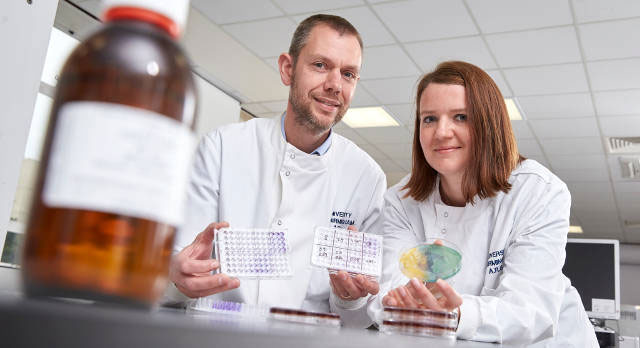
University of Birmingham clinical research fellow Dr Mark Webber and NIHR SRMRC clinical scientist Fenella Halstead.

University of Birmingham clinical research fellow Dr Mark Webber and NIHR SRMRC clinical scientist Fenella Halstead.

University of Birmingham clinical research fellow Dr Mark Webber and NIHR SRMRC clinical scientist Fenella Halstead.
Researchers from the National Institute for Health Research Surgical Reconstruction and Microbiology Research Centre (NIHR SRMRC) investigated the antibacterial activity of acetic acid against key burn wound colonising organisms growing both planktonically and as biofilms
Burns are a common traumatic injury and with a high risk of subsequent infection due to loss of the normal skin barrier. This can lead to sepsis (blood poisoning), which is the leading cause of death in patients with burn wounds.
Infection in burns is hard to treat with traditional antibiotics, however, as they do not effectively reach the wound and the infecting organisms are often highly antibiotic-resistant.
But now two studies by the Birmingham team, one published in Burns and the other in PLOS ONE, have demonstrated that low concentrations of acetic acid can be used as alternatives to topical (surface applied) antimicrobials and traditional antimicrobial dressings to treat and prevent bacterial colonisation of burns.
The current use of acetic acid in clinical settings has been limited due to concerns of patient tolerability but this proof that it is effective at far lower concentrations than previously thought now offers hope for the development of novel treatments.
Miss Fenella Halstead, NIHR SRMRC Clinical Scientist at the Queen Elizabeth Hospital Birmingham (QEHB), explained: “As resistance to antibiotics grows, we need to find ways to replace them with alternative topical agents that can kill bacteria and help our burns patients. The evidence in this study offers great promise that acetic acid can be a cheap and effective alternative.”
The acid was tested against 29 common wound-infecting pathogens, including Pseudomonas aeruginosa and Acinetobacter baumannii, grown in the laboratory.
The ability of highly diluted acetic acid to inhibit growth of pathogens, prevent the formation of biofilms, and then eradicate pre-formed biofilms was tested, with low concentrations (0.16-0.3%) shown to inhibit growth of all strains, prevent them from forming biofilms (bacteria attached to a surface) and also to eradicate mature biofilms after three hours of exposure.
Previous clinical use of acetic acid as an antimicrobial treatment has used much higher concentrations of 2.5%.
Miss Halstead continued: “A key way in which bacteria cause infection is in a biofilm; where instead of living as single cells they form a community in the form of a slimy layer that we see on a wound, on a valve or on a catheter, for instance.”
“As much as 80 per cent of infections in the body are due to these biofilms which, typically, are even more resistant to antibiotics because they essentially have safety in numbers and their metabolic rate is a lot slower. For that reason, seeing that acetic acid was effective against all types of these pathogens was really great.”
The team are now planning clinical trials in which they will test the effectiveness of two specific concentrations of acetic acid on patients at the Healing Foundation Centre for Burns Research at QEHB.
A further study will also test the effectiveness of plain dressings soaked with acetic acid, against the more commonly used, but more expensive, silver-based dressings.
Dr Mark Webber, from the University of Birmingham, added: “Acetic acid, or more commonly, vinegar, has been used sporadically in medicine for the past 6,000 years – being successfully implemented to treat plague, ear, chest, and urinary tract infections.
“In that sense, it’s a well-known antimicrobial which has seen sporadic clinical application. Our work now gives a firm evidence base to guide the development of treatments which promise to be cheap and effective.
“These new trials will hopefully provide clarity on how this can be implemented for burns patients across the world.
“However, more work still needs to be done to determine the best ways to use acetic acid, or similar chemicals, to treat and prevent bacterial infection.”
He stressed, though, that people should not start applying vinegar from their food cupboards onto burns and wounds at home but should seek proper medical advice as usual. The acetic acid used in the lab tests is highly diluted and in its pure form.